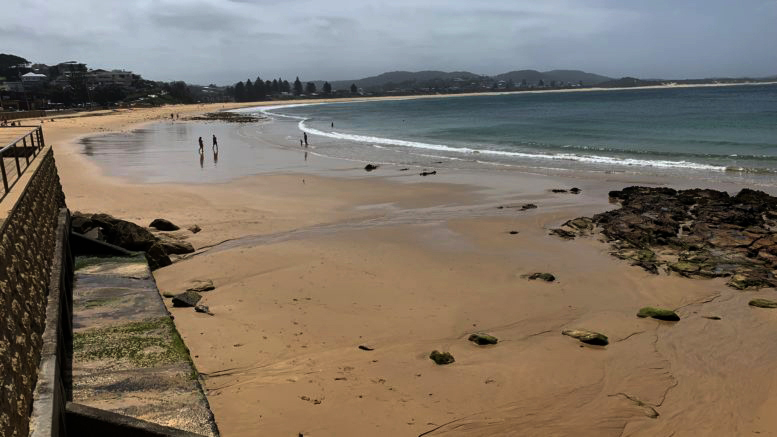The 2022-2023 State of the Beaches Report has seen 94 per cent of the Central Coast’s 15 beaches and three ocean baths receive a Good or Very Good rating, with Terrigal Beach the only one to retain a Poor rating.
Toowoon Bay returned to a Good rating after being classified Poor last year, despite the lagging influence on the results from the two La Nina years of 2021 and 2022.
It was the only Central Coast waterway to record an improved result over the previous year.
North Entrance Beach was the only Central Coast waterway to receive a Very Good rating.
Once again, the region’s estuarine sites, lakes and lagoons have all attracted a Poor rating, largely due to above average rainfalls during Winter and Spring last year.
Central Coast Council’s Director Environment and Planning Alice Howe said the annual report was an important resource to help Council manage water quality at swimming sites across the region.
“Beachwatch is a state-wide public health program monitoring water quality at swimming sites to ensure they are safe for swimming and the public have a way to find out likely pollution levels,” she said.
“The program aims to provide the community with access to a predictive model of likely water quality at our beaches enabling individuals to make informed decisions about where and when to swim.
“Routine assessment also measures the impact of pollution sources, enables the effectiveness of stormwater and wastewater management practices to be assessed and highlights areas where further work is needed.”
Council monitors 32 recreational sites across the Coast – 15 ocean beaches, three ocean baths, four coastal lagoons and 10 estuary sites.
“Notably Toowoon Bay’s grading returned to Good which is an improvement on the results for 2021-2022, despite the lagging influence on the results from the two La Nina years of 2021 and 2022,” Howe said.
“Terrigal Beach has also been influenced by the lagging effect of La Nina, again being graded as Poor in 2022–2023.
“However, despite the Poor grade, water quality at this site during this year was mostly suitable for swimming with 93 per cent of samples within the safe swimming guidelines.
“It should be noted that beach grades are a long-term assessment of water quality based on the last 100 samples taken, in this case taken over the past four years – which means the La Nina conditions are also included in the assessment and continue to influence the result.”
Howe said although influences such as La Nina impacted results, Council’s extensive remedial work undertaken over the past four years was paying off.
“During 2019–2020 Central Coast Council, the then Department of Planning, Industry and Environment and the University of Technology Sydney (UTS) investigated the scale and extent of elevated bacterial levels at Terrigal Beach,” she said.
“Council used the findings from the investigation to detect and resolve water quality issues in the catchment.
“In 2019, Council instigated a widespread audit of the sewer and stormwater network.
“This involved extensive in-field and laboratory analysis to determine the pollution source, CCTV inspection of more than 50 km of sewer pipes in the Terrigal beach and lagoon catchments and the relining and upgrading of more than 32 km of pipes, and smoke and dye testing to identify illegal connections.
“Subsequent to remediation work, Terrigal Beach was graded as Good for two consecutive years (2018-19 and 2019-20).
“In 2020-21 and 2021-22 Terrigal Beach returned to a Poor grade reflecting the extreme wet weather conditions of these two La Nina years impacting water quality at the beach.
“We would hope that as the lagging effects of La Nina, and Council’s ongoing remediation works continue, Terrigal will see an improved formal rating in the future.”

The 2022-23 report has again seen poor results at all Central Coast estuary sites.
“This is reflective of the nature of these waterways which flush very slowly, and which have greater impact from stormwater networks,” Howe said.
“Council is undertaking ongoing studies to determine the causes of these poorer results and remedial work when infrastructure failure is detected.
“Recent DNA studies on microbial sources has detected human, canine and avian sources to microbial contamination highlighting that both Council and the community have a role in improving our estuarine water quality.”
Howe said the report was a timely reminder that all swimming sites could be affected by stormwater pollution.
Council recommends that you should avoid swimming at ocean beaches for 24 hours after rain and 72 hours at estuary sites.
Council Administrator Rik Hart said it was very pleasing to see that most sites remained stable, with improvements at Toowoon Bay.
“To see that 94 per cent of ocean beaches and ocean baths are Good to Very Good, is evidence of the ongoing work Council has undertaken including audits and remedial work in our waterway catchments, to ensure the quality of the beaches,” he said.
“The numerous beautiful beaches of the Central Coast are at the heart of what makes this region special and it is vital that we take care of these precious waterways.
“While our State of the Beaches report card for 2022-2023 saw improvement, we will continue to roll out a number of measures designed to further improve water quality across the Coast.”
The ratings are based on microbial water quality, with Very Good indicating generally excellent quality, suitable for swimming almost all of the time.
Good indicates generally good water quality, suitable for swimming most of the time and Poor indicates the location is susceptible to faecal pollution and the water is not always suitable for swimming.
To view the State of the Beaches report and check Beachwatch daily forecast for reliable information on water quality visit: www.beachwatch.nsw.gov.au
Terry Collins


